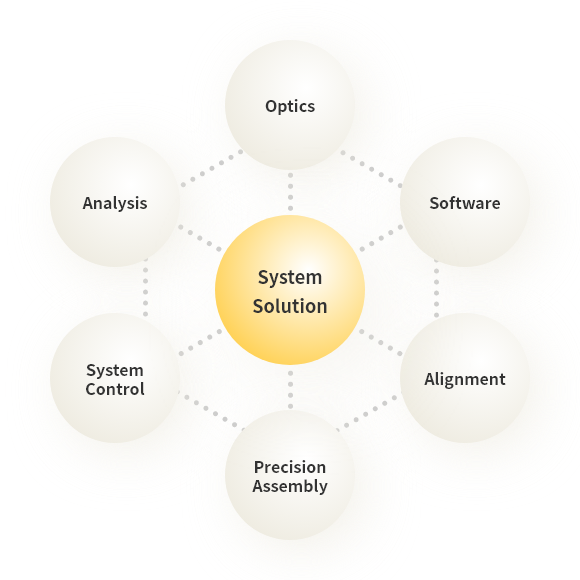We Utilize Our Extensive Expertise to Integrate Various Core Technologies, Delivering Solutions That Exceed Our Customers' Expectations
We create new value by integrating our extensive know-how and diverse core technologies from industrial automation equipment. Using our expertise in exposure systems, we employ advanced optical technologies with various wavelengths of light. We also apply high-precision alignment and analysis technologies to ensure product quality and reliability. Our evolving technology and strong conceptual skills enable us to provide solutions that exceed customer expectations.

Technology Overview
Optical Technologies
Combining various light sources and mechanisms—UV lamps, xenon lamps, halogen, laser diodes, LEDs, and more—our advanced light control technologies support cutting-edge electronics fields. By mastering diverse light functions such as "drawing," "solidifying," and "inspecting," we provide optimal solutions tailored to our customers' manufacturing environments.

Drawing with Light
Printed circuit boards(PCB) and semiconductors are now found in a wide range of devices, including smartphones, gaming consoles, computers, home appliances, and automobiles. Among the manufacturing processes for these components, the most crucial is the exposure technology used to create fine electronic circuit patterns. We control light by analyzing and performing high-speed calculations on the light that enters the mirror mechanism from the light source using software. Our expertise in handling light enables us to achieve high-precision, high-speed exposure, resulting in exceptional productivity.
Hardening and Bonding with Light
We use ultraviolet (UV) curing resins, which harden instantly when exposed to UV light, to bond precision components such as optical and medical parts. This technology utilizes the chemical energy of UV light to cause molecular-level changes in materials, enabling the bonding of components.
Inspection with Light
By illuminating and reflecting light, we make it easier to detect scratches and defects on lenses, glass, and other surfaces. Selecting the optimal light source for the workpiece makes it easier to find defects and imperfections. Additionally, controlling specific light sources can protect the inspector's eyes during visual inspections.
Evaluation with Light
Our technology simulates sunlight with near-perfect accuracy using solar simulators. This technique is used for evaluating solar cells, assessing SPF and PA in cosmetics, calculating UV indexes, and testing light resistance in building materials and coatings.
Alignment Technology
Alignment refers to the position correction function achieved by combining cameras, lighting, and image processing systems to align the workpiece. In the fields of PCB and semiconductors, misalignment between the substrate and table during exposure can lead to defects. Our technology ensures high-level positioning by moving and adjusting the table to the target position through mechanical control.
This positioning technology is widely applicable beyond exposure systems and is crucial for factory automation (FA). It is essential for improving production process quality and is used in various applications, including assembly of parts and products, transportation and placement in precision machinery, high-precision lamination, probe testing in solar cell and semiconductor inspection processes, measurement of label and barcode misalignment, IC chip orientation, inspection of lid misalignment on food containers, and machine tool position control. Our alignment technology contributes to enhanced product quality and productivity and is adaptable for automating a wide range of devices.

Analysis Technology
Analysis technology plays a crucial role in manufacturing. In the production of semiconductors and PCB, the presence of fine particles on the product during manufacturing can significantly impact quality. To maintain cleanliness within the equipment, we use a downflow structure combined with HEPA filters to suppress dust generation. This setup is analyzed using dedicated software for fluid analysis, which numerically calculates and visualizes the flow conditions of gases and liquids (such as flow rate, pressure, and temperature changes).
This analysis technology is indispensable not only in exposure systems but also in a wide range of devices, including liquid crystal panel manufacturing equipment, electronic component inspection systems, medical equipment, and vacuum systems. Additionally, in the case of precision-machined parts, structural analysis (strength analysis) is conducted during the product design phase to verify that the product can withstand its intended environment. This helps ensure that products do not fail under unexpected conditions after market introduction, protecting users from potential risks.
The accumulation of these technical innovations and analysis processes significantly contributes to the stability of equipment and product quality.
